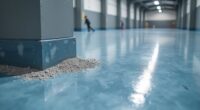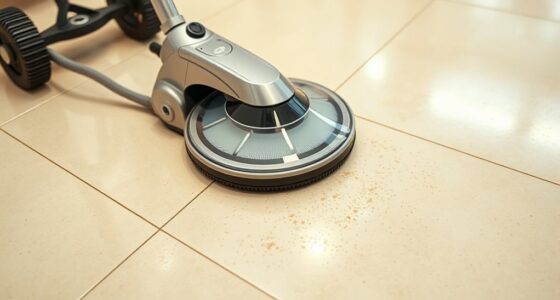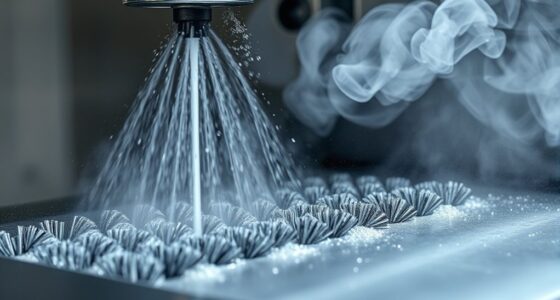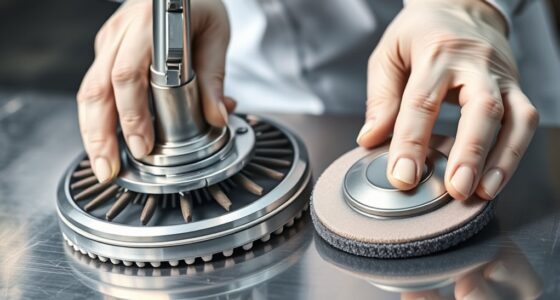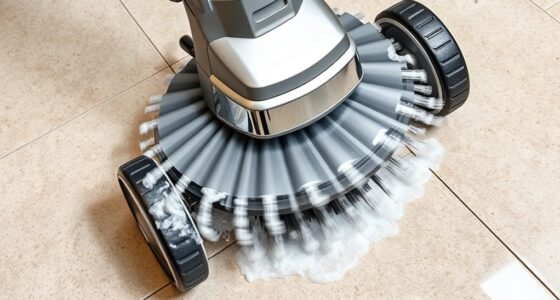Scrubbing your floors regularly helps preserve their surface texture, which is essential for slip resistance and maintaining a good COF. Proper cleaning removes dirt, grease, and slippery residues that can reduce traction. When done gently with the right tools, scrubbing exposes the floor’s micro-roughness, enhancing grip. Keep in mind that both the surface and your footwear matter. If you’re interested in learning more about how cleaning techniques impact safety, just continue exploring.)
Key Takeaways
- Regular scrubbing maintains and restores surface micro-roughness, enhancing slip resistance and increasing the coefficient of friction (COF).
- Gentle cleaning removes dirt, grease, and slippery residues that can lower the surface’s natural traction.
- Overly abrasive tools or harsh chemicals can smooth or damage the surface, reducing its micro-roughness and slip resistance.
- Proper maintenance prevents buildup of contaminants that act as lubricants, helping preserve the floor’s grip.
- Cleaning methods should balance effective dirt removal with preserving surface texture to sustain optimal traction.

Understanding slip resistance and the coefficient of friction (COF) is essential for ensuring safety in various environments. When it comes to preventing slips and falls, the surface texture of a flooring material plays a vital role. A rougher, more textured surface provides better grip because it increases the contact points between your shoes and the floor. Conversely, smooth or polished surfaces tend to reduce slip resistance, especially when wet or oily. That’s why, when choosing flooring, you should always consider how the surface texture interacts with typical foot traffic and environmental conditions. A textured surface can markedly improve traction, but only if your footwear is compatible with it. Shoes with worn-out soles or inappropriate tread patterns can diminish the benefits of a textured surface, making it more likely for you to slip even on seemingly safe floors. Ensuring your footwear has suitable tread and sole material is just as important as the surface texture itself. If your shoes don’t grip well, no amount of surface roughness will prevent slips, regardless of how textured the floor is.
Proper maintenance of surface texture, including scrubbing, helps sustain its traction qualities and prevents deterioration over time. Scrubbing or cleaning the floor can also impact its slip resistance. Regular scrubbing helps remove dirt, grease, and other contaminants that can act as lubricants between your shoes and the floor, lowering the COF. When you scrub, you restore the surface’s natural grip by exposing the original texture, removing slippery residues, and maintaining a clean, traction-friendly environment. However, it’s essential to use the right cleaning tools and methods. Using overly abrasive scrub brushes or harsh chemicals can alter the surface texture, sometimes smoothing out micro-roughness or creating uneven patches that compromise slip resistance. Proper scrubbing techniques involve gentle but thorough cleaning, ensuring the surface texture remains effective in providing traction. Additionally, frequent cleaning prevents the buildup of slippery substances, which could otherwise diminish the floor’s natural grip over time.
To maximize safety, you need to pay attention to both the surface texture and footwear compatibility, especially after scrubbing. When the floor is kept clean and textured appropriately, and you wear footwear suited to the environment, you create a safer space for everyone. Regular maintenance, including proper scrubbing, helps preserve the floor’s traction qualities, ensuring the COF stays within safe limits. Remember, slip resistance isn’t just about the floor material but how well the floor and your shoes work together under different conditions. So, by understanding how surface texture influences traction and choosing footwear that complements those surfaces, you can markedly reduce slip hazards and foster safer environments for yourself and others.
Frequently Asked Questions
How Often Should Flooring Be Scrubbed to Maintain Optimal Slip Resistance?
You should scrub your flooring at least once a week to maintain ideal slip resistance. Regular cleaning is essential for effective floor maintenance and helps preserve the coefficient of friction (COF). If your environment sees heavy foot traffic or spills often, increase cleaning frequency. Consistent scrubbing removes debris and grime that can reduce traction, ensuring your floors stay safe and slip-resistant.
Can Scrubbing Damage the Surface and Reduce Its Slip Resistance Over Time?
Scrubbing can cause surface degradation and abrasion effects that might reduce slip resistance over time if done excessively or with harsh materials. However, gentle, proper cleaning methods help maintain traction without damaging the surface. You should balance cleaning frequency and technique carefully. Regular, moderate scrubbing preserves the surface’s integrity, ensuring it remains slip-resistant, while aggressive or over-frequent scrubbing risks damaging the surface and diminishing its traction.
What Cleaning Agents Are Best for Preserving the Floor’s Traction After Scrubbing?
For maximum traction preservation after scrubbing, you should choose cleaning agents specifically designed for your floor type. Use pH-neutral cleaners that are gentle yet effective, avoiding harsh chemicals that can damage the surface or reduce slip resistance. Always follow manufacturer recommendations for cleaning agents and dilution ratios. Regularly inspect your floor to guarantee it maintains its traction, and consider reapplying slip-resistant treatments if needed to keep surfaces safe.
Does Increased Scrubbing Intensity Improve or Diminish the Floor’s COF?
Think of your floor like a well-worn path; increased scrubbing intensity can be like a gust of wind smoothing the trail, diminishing its grip. Higher abrasion impact from aggressive scrubbing often makes the surface smoother, which can lower the coefficient of friction (COF). So, while it might clean better, overdoing it diminishes traction, risking slips. Balance scrubbing to preserve surface roughness and maintain ideal traction.
Are There Specific Scrubbing Techniques Recommended for Different Flooring Materials?
You should tailor your scrubbing methods to different flooring types for maximum traction. For tile or vinyl, use gentle, circular scrubbing to avoid damage. For concrete or textured surfaces, apply more vigorous scrubbing with a stiff-bristle brush. Always choose appropriate cleaning solutions and avoid excessive scrubbing that could diminish slip resistance. Adjust your techniques based on flooring material to maintain or improve their slip resistance and guarantee safety.
Conclusion
So, next time you scrub a floor to improve slip resistance, remember—it might just be giving you a false sense of security. While you think you’re boosting traction, the truth is, your efforts could be subtly eroding the very grip you seek. Ironically, in trying to prevent slips, you might be unknowingly making surfaces more unpredictable. Sometimes, less scrubbing and more understanding of COF is the real game-changer in staying safe.

